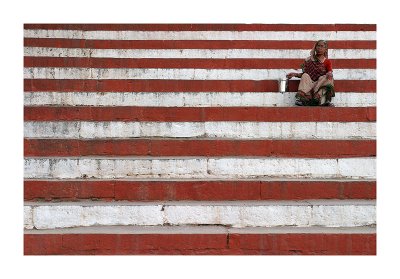
A woman sitting on the white and red-striped ghats, not far from Assi ghats in Varanasi. I couldn’t resist the pun in French (Assi sounds like “assis” = sitting). Those ghats lead to a temple and the stripes mark the sacredness of the area.
Benares has been a pilgrimage centre since time immemorial. It is believed that the fifth head of Brahma which clung to Shiva's palms, came unstuck only after he reached Varanasi. The town is mentioned in the Tamil Tevaram hymns of the first millennium. Kasi repeatedly appears in scriptures such as the Brahmanas, Upanishads, Kavyas and Puranas. It is the oldest centre of learning and is vibrant with centuries of tradition. The last of the sacred spots is the Manikarnika Ghat. Legend has it that Vishnu dug a pit with his chakra, and the sweat created during his meditation filled the pit. Shiva shook his head and his jewelled earring fell into the pit, hence the name Manikarnika. According to tradition, those that die at Benares and get cremated at the Manikarnika ghat, get liberated from the cycle of life and death.
Hyuen Tsang, the Chinese traveller visited Varanasi in the 7th century. His travel accounts speak of the grandeur of the city and of its temples. This writer describes a hundred feet high statue of Shiva Maheshwara made of brass that adorned the city. Several other temples and shrines abound in the city of Benares. Virtually every block houses a shrine here.

Aucun commentaire:
Enregistrer un commentaire